#September 2022 Science News
Text
Though the Centers for Disease Control and Prevention has stopped counting Covid-19 cases, according to wastewater data—which emerged early on as an accurate tracker of the ebbs and flows of the virus—we are currently in one of the biggest surges of the pandemic, amid the spread of a new variant, JN-1, as the virus keeps mutating. More than three-quarters of U.S. hospital beds are currently in use due to Covid hospitalizations. Uptake of the most recent booster shot, which should help to protect against the new variant and lower the risk of severe cases and the odds of getting long Covid, hovers around 19 percent.
Meanwhile, the most recent White House response to a question about whether they had any guidance for hospitals, some of which have brought back mitigation protocols in response to the most recent Covid spike, came courtesy of press secretary Karine Jean-Pierre: “Hospitals, communities, states, they have to make their own decisions. That’s not something we get involved in,” she replied, appearing exasperated.
“We are in possibly the second-biggest surge of the pandemic if you look at wastewater levels,” said Dr. Monica Verduzco-Gutierrez, who runs a long-Covid clinic at the University of Texas, San Antonio, and has had ongoing Covid symptoms since August 2022. “There is no urgency to this. No news. No discussion in Congress. There is no education.”
[...]
Since the Biden administration declared the end of the national emergency in May, Americans across the political spectrum have largely followed the example set by the government and entirely disposed of any level of Covid precautions. Liberal and left-wing outlets have participated in the normalizing of Covid too, dismissing or even ostracizing people who still take precautions as if they are tin-hat conspiracy theorists. “We can’t be in lockdown forever,” has become a common refrain, as if wearing a mask on the subway constitutes “lockdown.”
In September, Biden himself participated in the spread of this kind of harmful disinformation when he declared the pandemic “over” on 60 Minutes. “If you notice, no one’s wearing masks,” he said. “Everybody seems to be in pretty good shape.” This is, essentially, governing via “vibes”—so much for “following the science.”
[...]
The consequences of discarding all Covid precautions are becoming clearer, as more people get repeated infections and long-term symptoms, amid an alarming spike in heart problems among healthy young people. People are getting sick more often not due to the myth of “immunity debt,” which posits that the lack of exposure to other people during lockdown has made people less able to fight off infections (three years later), but because Covid weakens the immune system. Each time someone contracts Covid, the odds of long-term complications increase.
521 notes
·
View notes
Text
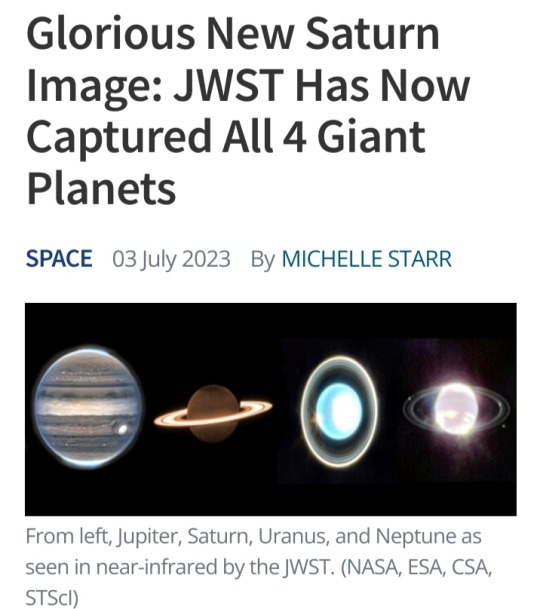
With the addition of Saturn, the James Webb Space Telescope has finally captured all four of our Solar System's giant worlds.
JWST's observations of the ringed planet, taken on 25 June 2023, have been cleaned up and processed, giving us a spectacular view of Saturn's glorious rings, shining golden in the darkness.
By contrast, the disk of Saturn is quite dark in the new image, lacking its characteristic bands of cloud, appearing a relatively featureless dim brown.
This is because of the wavelengths in which JWST sees the Universe – near- and mid-infrared.
These wavelengths of light are usually invisible to the naked human eye, but they can reveal a lot.
For example, thermal emission – associated with heat – is dominated by infrared wavelengths.
When you're trying to learn about what's going on inside a planet wrapped in thick, opaque clouds, studying its temperature is a valuable way to go about it.
Some elements and chemical processes emit infrared light, too. Seeing the planets of the Solar System in wavelengths outside the narrow range admitted by our vision can tell us a lot more about what they have going on.
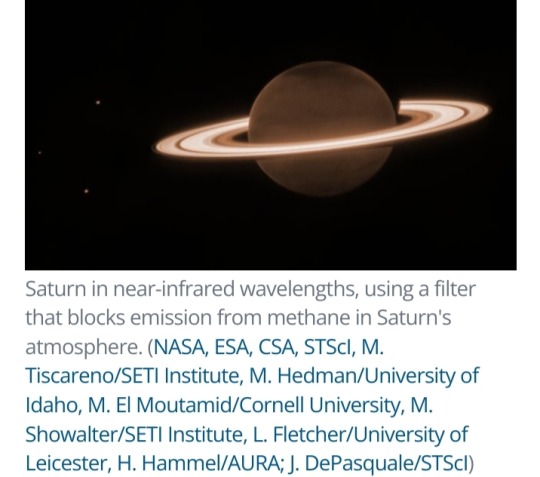
Saturn
As we saw last week, when we clapped eyes on the raw JWST Saturn images, the observations involved filters that dimmed the light of the planet, while allowing light from the rings and moons to shine brightly.
This is so a team led by planetary scientist Leigh Fletcher of the University of Leicester in the UK can study the rings and moons of Saturn in more detail.
They hope to identify new ring structures and, potentially, even new moons orbiting the gas giant.
The image above shows three of Saturn's moons, Dione, Enceladus and Tethys, to the left of the planet.
Although dim, the disk of the planet also reveals information about Saturn's seasonal changes.
The northern hemisphere is reaching the end of its 7-year summer, but the polar region is dark. An unknown aerosol process could be responsible.
Meanwhile, the atmosphere around the edges of the disk appears bright, which could be the result of methane fluorescence, or the glow of trihydrogen, or both. Further analysis could tell us which.

Jupiter
Jupiter was the first of the giant planets to get the JWST treatment, with images dropping in August of last year – and boy howdy were they stunning.
The spectacular detail seen in the planet's turbulent clouds and storms was perhaps not entirely surprising.
However, we also got treated to some rarely seen features: the permanent aurorae that shimmer at Jupiter's poles, invisible in optical wavelengths, and Jupiter's tenuous rings.
We also saw two of the planet's smaller, lesser-known moons, Amalthea and Adrastea, with fuzzy blobs of distant galaxies in the background.
"This one image sums up the science of our Jupiter system program, which studies the dynamics and chemistry of Jupiter itself, its rings, and its satellite system," said astronomer Thierry Fouchet of Paris Observatory in France, who co-led the observations.
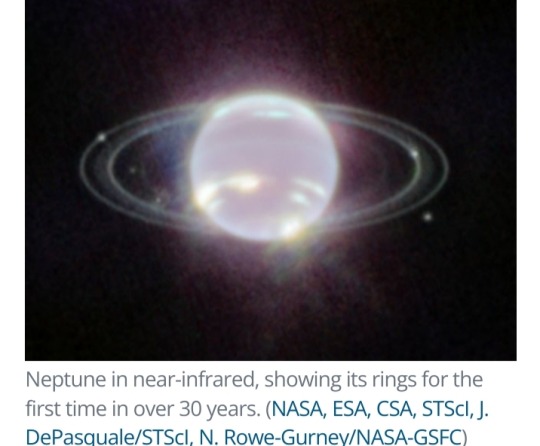
Neptune
Observations of Neptune arrived in the latter half of September 2022.
Because Neptune is so very far away, it tends to get a little neglected; you're probably used to seeing, if anything, the images taken by Voyager 2 when it flew past in 1989.
JWST's observations gave us, for the first time in more than 30 years, a new look at the ice giant's dainty rings – and the first ever in infrared.
It also revealed seven of Neptune's 14 known moons, and bright spots in its atmosphere.
Most of those are storm activity, but if you look closely, you'll see a bright band circling the planet's equator.
This had never been seen before and could be, scientists say, a signature of Neptune's global atmospheric circulation.
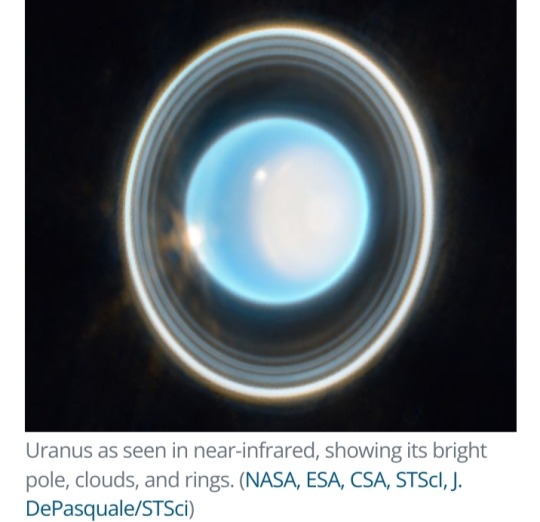
Uranus
Uranus is also pretty far away, but it's also a huge weirdo. Although very similar to Neptune, the two planets are slightly different hues, which is something of a mystery.
Uranus is also tipped sideways, which is challenging to explain too.
JWST's observations, released in April 2023, aren't solving these conundrums.
However, they have revealed 11 of the 13 structures of the incredible Uranian ring system and an unexplained atmospheric brightening over the planet's polar cap.
JWST has a lot to say about the early Universe; but it's opening up space science close to home, too.
As its first year of operations comes to an end, we can't help but speculate what new wonders will be to come in the years ahead.

Top: Jupiter - Neptune / Bottom: Uranus - Saturn
Credit: NASA
#James Webb Space Telescope#Solar System#Saturn#Jupiter#Uranus#Neptune#planets#space#universe#infrared wavelengths#wavelengths#JWST#Leigh Fletcher#planetary science#Thierry Fouchet#moons#Voyager 2#giant planets#astronomy
1K notes
·
View notes
Text
great news
at least 2.5 million ants for every human being
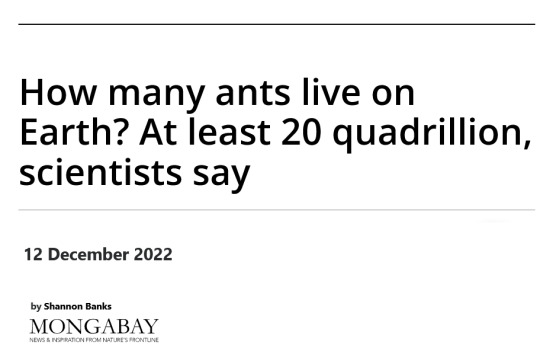


Headline, image, caption, and text as published by: Shannon Banks. “How many ants live on Earth? At least 20 quadrillion, scientists say.” Mongabay. 12 December 2022. [Reporting on this new paper: P. Schultheiss et. al. “The abundance, biomass, and distribution of ants on Earth.” Proceedings of the National Academy of Sciences, 119 (40). September 2022.]
1K notes
·
View notes
Text

September 2022 is the month marking 35 years of Star Trek TNG, the show that introduced me to the Star Trek universe and Science Fiction as a whole, and shaped so much of my life.
Over on Twitter, I was asked to take part in the #TNG35Art, where many artists who love TNG will be showing art they made in celebration each day of the month.
I had the pleasure of making this portrait of Guinan, with her knowing gaze and enigmatic smile. I am looking forward to seeing the art this month in celebration of Star Trek and following some new artists <3
#star trek#star trek art#star trek fanart#star trek tng#st tng#star trek the next generation#guinan#illustration#art#artists on tumblr
819 notes
·
View notes
Photo


The Stronsay Beast [modern cryptid; globster]
In September of 1808, a strange marine creature washed ashore on a beach of Stronsay in the Scottish Orkney Islands (at the time, the island was called Stronsa). It resembled no known animal, having six arms, paws or wings, which were about 4.5 feet (1.4m) long and resembled plucked goose wings. When the news reached universities and scientific institutions, anatomists were called upon to visit the carcass and find out what kind of animal it was. Unfortunately, by the time these scientific men reached the ‘Stronsay Beast’ – as people had taken to calling it – the corpse was decomposed and weathered beyond repair. Few biological traits remained recognizable, so eyewitnesses were called upon to describe what the creature had looked like.
According to these eyewitness reports, the creature was about 55 feet (16.8m) long when it washed ashore and had a long and thin neck. At the end of the tail was something resembling an ear.
Scientists were puzzled, and some were of the opinion that this creature must have been a sea serpent, whose existence was considered plausible by many at the time. Spearheading them was John Barclay, a respected professor in anatomy at Edinburgh University who adamantly claimed that the carcass was the first solid evidence of the existence of giant sea serpents. His opinion was opposed by Everard Home, sergeant-surgeon and lecturer in surgery and anatomy at London’s Royal College of Surgeons. He did not believe in great sea snakes and claimed that the ‘beast’ was simply the torn and shredded carcass of a basking shark. He dismissed the eyewitnesses as unscientific and relied only on the shape of the bones that were found within the corpse.
During the discussions on the nature of the beast, reverend Donald Maclean entered the stage and claimed to have seen the creature alive in June, several months before it washed ashore, near the coast of the island Coll. The reverend claimed that the creature had a small neck with a broad, somewhat oval-shaped head that looked at his ship. Alarmed by the approaching animal, the boat was steered towards the shore. Eventually, the water became too shallow for the large creature and it returned to the open waters. The reverend also estimated that the creature was about 70 to 80 feet long (21 to 24m), which is much larger than the corpse on the beach. Additionally, he claimed to have questioned the crews of several fishing vessels that supposedly also encountered the creature. According to these reports, the monster had a head as big as a small boat with big eyes as large as plates. Although it looked terrifying, the creature did not attack.
Eventually, belief in the existence of giant sea snakes died out (at least within the scientific community) and Barclay’s conclusion was no longer taken seriously. Today, biologists agree with Home that the creature must have been a dead basking shark, or rather the damaged remains of one.
Source:
Jenkins, B., 2022, The ‘Stronsay Beast’: testimony, evidence and authority in early nineteenth-century natural history, The Royal Society Journal of the History of Science, 0, published online.
(image source 1: MechaDaveO on Deviantart)
(image 2: Home’s drawing of a basking shark compared to a reconstruction of the Stronsay Beast based on eyewitness reports, on the same scale. Image source: Phil. Trans. R. Society of London, 99, 206-220 (1809).)
155 notes
·
View notes
Text
The Top 7 Best News of Last Week — August 22, 2022
🎉🎈 — I created this newsletter exactly one year ago! I hope I have made your weeks slightly better. Thank you for being a subscriber
1. New California law now mandates that the school day start no earlier than 8 am for middle graders and 8:30 am for high schoolers.
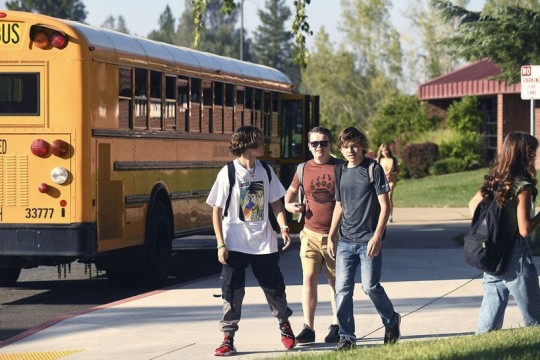
The start of the new school year is right around the corner! And for most middle and high schoolers, that could mean getting more sleep. Starting July 1, a California state law now requires middle school start no earlier than 8 a.m.
For high school, it’s 8:30 a.m. “This is a public health issue because the sleep deprivation in teens is really at epidemic levels,” said Joy Wake, Policy and Advocacy Director for Start School Later.
2. Pennsylvania governor signs executive order banning conversion therapy

Pennsylvania Gov. Tom Wolf signed an executive order Tuesday to ban conversion therapy, a discredited form of therapy that seeks to change someone’s sexual orientation or gender identity, for minors.
The executive order directs state agencies to discourage conversion therapy for people of all ages, and to instead promote evidence-based practices for supporting LGBTQ people. The order also directs the Department of Human Services, among other agencies, to ensure that state funds are not being used to provide or reimburse for conversion therapy.
3. First Native American woman to travel to space
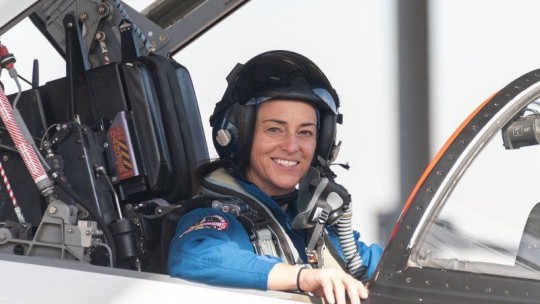
Astronaut Nicole Aunapu Mann, of the Wailacki of the Round Valley Indian Tribes, will be mission commander — responsible for all phases of flight. She will go to the International Space Station on 29 September, Nasa says.
“It’s very exciting,” she told newspaper Indian Country Today.
“I think it’s important that we communicate this to our community, so that other Native kids… realise that some of those barriers that used to be there are really starting to get broken down,” she added.
4. 100-acre no cage, no kill dog shelter opening in Alabama

Big Dog Ranch Rescue — the largest cage-free, no-kill rescue in the U.S. — is opening a 100-acre facility in Alabama.
The ranch will be located at the former home of a greyhound training facility in Shorter in Macon County and will serve as a rescue, rehabilitation, medical and adoption center for dogs across the south. The Alabama property will allow the rescue to save an additional 5,000 dogs each year.
5. Scotland to become first country in world to provide free period products

On Monday, when the Period Products Act comes into force, councils and education providers in Scotland will be legally required to ensure free sanitary products are available to anyone who needs them.
Scotland’s councils will each decide what exact arrangements are put in place, but they will have a legal obligation to give “anyone who needs them” access to a range of period products “reasonably easily”.
6. World’s smallest sea turtle nests in Louisiana for the first time in 75 years

“Louisiana was largely written off as a nesting spot for sea turtles decades ago, but this determination demonstrates why barrier island restoration is so important,” Chip Kline, chairman of the Louisiana Coastal Restoration and Protection Authority, said in a news release.
Crews monitoring the Chandeleur Islands — a chain 50 miles (80 kilometers) east of New Orleans — to help design a restoration project found tracks of females going to and from nests and of hatchlings leaving a nest.
7. Sacheen Littlefeather receives formal apology for mistreatment at 1973 Oscars.
youtube
The Academy of Motion Picture Arts and Sciences has formally apologized to Sacheen Littlefeather for her mistreatment at the 1973 Academy Awards, where the Native American actress and civil rights activist was booed and ridiculed as she declined the Best Actor award on Marlon Brando’s behalf.
“The abuse you endured because of this statement was unwarranted and unjustified,” Academy President David Rubin wrote in a “statement of reconciliation” sent to Littefeather in June, and posted on the Academy’s website Monday. “The emotional burden you have lived through and the cost to your own career in our industry are irreparable. For too long the courage you showed has been unacknowledged. For this, we offer both our deepest apologies and our sincere admiration.”
I love how she was able to apply humor to the situation. She quipped, “We Indians are very patient people. It’s only been 50 years”. Bless her, that’s awesome.
...
That's it for this week. This newsletter will always be free. If you liked this post you can support me with a small kofi donation:
Buy me a coffee ❤️
Have a great week ahead.
499 notes
·
View notes
Text
Enshitternet

Going to Burning Man? Catch me on Tuesday at 2:40pm on the Center Camp Stage for a talk about enshittification and how to reverse it; on Wednesday at noon, I'm hosting Dr Patrick Ball at Liminal Labs (6:15/F) for a talk on using statistics to prove high-level culpability in the recruitment of child soldiers.
On September 6 at 7pm, I'll be hosting Naomi Klein at the LA Public Library for the launch of Doppelganger.
On September 12 at 7pm, I'll be at Toronto's Another Story Bookshop with my new book The Internet Con: How to Seize the Means of Computation.

This week on my podcast, I read "Enshitternet: The old, good internet deserves a new, good internet," my recent Medium column about building a better internet:
https://doctorow.medium.com/enshitternet-c1d4252e5c6b
As John @hodgman is fond of reminding us, "nostalgia is a toxic impulse." It is easy for an old net.hand like me to fall into the trap of shaking his fist at the cloud. Having been on the other side of that dynamic, I can tell you it's no fun.
When I got on BBSes in the early 1980s, there was an omnipresent chorus of grumps insisting that the move from honest acoustic couplers to decadent modems was the end of the Golden Age of telecommunications:
https://en.wikipedia.org/wiki/Acoustic_coupler
When I got on Usenet shortly thereafter, the Unix Greybeard set never passed up an opportunity to tell us newcomers that the Fidonet-Usenet bridge allowed the barbarian hordes to overwhelm their Athenian marketplace of ideas:
https://technicshistory.com/2020/06/25/the-era-of-fragmentation-part-4-the-anarchists/
When I joined The WELL in the late 1980s, I was repeatedly assured that the good times were over, and that we would never see their like again:
https://www.well.com/
Now that I'm 52, I've learned to recognize this dynamic, from the Eternal September:
https://en.wikipedia.org/wiki/Eternal_September
to the moral panic over menuing systems replacing CLIs:
https://www.eff.org/deeplinks/2020/02/gopher-when-adversarial-interoperability-burrowed-under-gatekeepers-fortresses
to the culture wars over what would happen when the net got a normie-friendly GUI:
https://www.dejavu.org/1993win.htm
And yeah, I've done it too, explaining "Why I won’t buy an iPad (and think you shouldn’t, either)":
https://memex.craphound.com/2010/04/01/why-i-wont-buy-an-ipad-and-think-you-shouldnt-either/
But there's a key difference between my own warnings about the enshittification that new "user friendly" technologies would engender and all those other AARP members' complaints: they were wrong, and I was right.
As Tom Eastman reminded us, the internet really was better, back before it became "five giant websites filled with screenshots of text of the other four":
https://twitter.com/tveastman/status/1069674780826071040
The underlying pathology of that enshittification wasn't the UI, or whether it involved an app store. As the Luddites knew, the important thing about a technology isn't what it does, but who it does it for and who it does it to:
https://locusmag.com/2022/01/cory-doctorow-science-fiction-is-a-luddite-literature/
The problem wasn't which technology we used. There is nothing inherent about touchscreens that makes them into prisons that trap users, rather than walled gardens that protect them.
Likewise, the problem wasn't who made that technology. We didn't swap wise UUCP Monks for venal tech bros. The early tech world was full of public-spirited sysops, but it was also full of would-be monopolists who tried – and failed – to get us to "stop talking to each other and start buying things":
https://catvalente.substack.com/p/stop-talking-to-each-other-and-start
If it wasn't the technology that killed the old, good internet, and if it wasn't the people who killed the old, good internet, where did the enshitternet come from?
It wasn't the wrong tech, it wasn't the wrong people: it was the wrong rules. After all, the Apple ][+ went on sale the year Ronald Reagan hit the campaign trail. Consumer tech was the first industry born after antitrust was dismantled, and it created the modern monopoly playbook: buying and merging with competitors. The resulting unity of purpose and anticompetitive profit margins allowed tech to capture its regulators and secure favorable court and legislative outcomes.
The simultaneous drawdown of antitrust enforcement and growth of tech meant that tech's long-standing cycle of renewal was ended. Tech companies that owed their existence to their ability to reverse-engineer incumbent companies' products and make interoperable replacements and add-ons were able to ban anyone else from doing unto them as they did unto the giants that came before them:
https://doctorow.medium.com/let-the-platforms-burn-6fb3e6c0d980
The pirates became admirals, and set about creating a "felony contempt of business model":
https://pluralistic.net/2022/12/03/painful-burning-dribble/#law-of-intended-consequences
They changed the rules to ensure that they could "disrupt" anyone they chose, but could themselves mobilize the full might of the US government to prevent anyone from disrupting them:
https://locusmag.com/2019/01/cory-doctorow-disruption-for-thee-but-not-for-me/
The old, good internet was the internet we we able to make while tech was still realizing the new anticompetitive powers it had at its disposal, and it disappeared because every administration, R and D, from Reagan to Trump, yanked more and more Jenga blocks out of the antitrust tower.
In other words: the old, good internet was always doomed, because it was being frantically built in an ever-contracting zone of freedom to tinker, where technologies could be operated by and for the people who used them.
Today, the Biden administration has ushered in a new era of antitrust renewal, planting the seeds of a disenshittification movement that will tame corporate power rather than nurturing it:
https://www.eff.org/de/deeplinks/2021/08/party-its-1979-og-antitrust-back-baby
In other words, we are living in the first days of a better nation.
In other words, rather than restoring the old, good internet, we should build a new, good internet.
What is a new, good internet? It's an internet where it's legal to:
reverse-engineer the products and services you use, to add interoperability to them so you can leave a social network without leaving your friends:
https://www.eff.org/interoperablefacebook
jailbreak devices to remove antifeatures, like surveillance, ink-locking, or repair-blocking:
https://pluralistic.net/2023/04/17/have-you-tried-not-spying/#coppa
move your media files and apps from any platform to any device or service, even if the company that sold them to you objects:
https://pluralistic.net/2022/09/07/audible-exclusive/#audiblegate
A new, good internet gives powers to users, and takes power away from corporations:
https://doctorow.medium.com/twiddler-1b5c9690cce6
On a new, good internet, companies can't practice algorithmic wage discrimination:
https://pluralistic.net/2023/04/12/algorithmic-wage-discrimination/#fishers-of-men
They can't turn search into an auction between companies that match your query and companies that want to sell you fakes and knockoffs:
https://pluralistic.net/2022/11/28/enshittification/#relentless-payola
They can't charge rent to the people whose feeds you asked to read for the privilege of reaching you:
https://pluralistic.net/2022/12/10/e2e/#the-censors-pen
In fact, a new, good internet is one where we euthanize rentiers:
https://pluralistic.net/2023/07/24/rent-to-pwn/#kitt-is-a-demon
On the new good internet, your boss can't use bossware to turn "work from home" into "live at work":
https://pluralistic.net/2021/02/24/gwb-rumsfeld-monsters/#bossware
And on top of that, you have the right to hack that bossware to undetectably disable it (and hackers have the right to sell or give you that hack):
https://www.eff.org/deeplinks/2021/08/tech-rights-are-workers-rights-doordash-edition
On the new, good internet, we stop pretending that tech is stealing content from news companies, and focus on how tech steals money from the news, with app taxes, rigged ad markets, surveillance ads, and payola:
https://www.eff.org/deeplinks/2023/04/saving-news-big-tech
The new, good internet is an internet where we seize the means of computation. It's an internet operated by and for the people who use it.
Hodgman is right. Nostalgia is a toxic impulse. The point of making a new, good internet isn't to revive the old, good internet. There were plenty of problems with the old, good internet. The point is to make a new, good internet that is the worthy successor to the old, good internet – and to consign the enshitternet to the scrapheap of history, an unfortunate transitional stage between one good internet and another.
Here's a link to the podcast episode:
https://craphound.com/news/2023/08/21/enshitternet-the-old-good-internet-deserves-a-new-good-internet/
and here's a direct link to the MP3 (hosting courtesy of the Internet Archive; they'll host your stuff for free, forever):
https://archive.org/download/Cory_Doctorow_Podcast_448/Cory_Doctorow_Podcast_448_-_Enshitternet.mp3
and here's a link to my podcast's RSS feed:
https://feeds.feedburner.com/doctorow_podcast

If you'd like an essay-formatted version of this post to read or share, here's a link to it on pluralistic.net, my surveillance-free, ad-free, tracker-free blog:
https://pluralistic.net/2023/08/22/the-new-good-internet/#the-old-good-internet

Image:
Cryteria (modified)
https://commons.wikimedia.org/wiki/File:HAL9000.svg
CC BY 3.0
https://creativecommons.org/licenses/by/3.0/deed.en
#podcasts#mp3s#enshittification#nostalgia#nostalgia is a toxic impulse#spoken word#the old good internet#the new good internet
60 notes
·
View notes
Text
Arctic Monkeys' Alex Turner on Sinatra, the tao of Natalie Imbruglia's 'Torn,' and the songs that make him cry (Entertainment Weekly)
On the eve of their new album, The Car, the Britpop giants' frontman shares the soundtrack of his life.
By Leah Greenblatt, October 19, 2022 at 03:00 PM EDT
Soundtrack of My Life is a recurring column in which musicians recall their favorite songs, artists, and albums.
Seated in a shabby-chic hotel lounge on a blazing September day in New York City, Alex Turner looks like the timeless picture of a louche, untouchable rock star: slick swoop of chestnut hair, fine gold chain glimmering on his neck, indefinable swagger. Even his late-summer sweater, some kind of gossamer knit rendered in the rich sea-foam green of Pantone swatches or private Aegean islands, looks both expensive and effortless.
But the frontman of arguably one of the biggest bands of this millennium is endearingly uncool when it comes to showing up for the assignment — in this case a look back at the songs and artists who shaped him as a boy growing up in Sheffield, England, the only child of two secondary school teachers. "I was racking me brain for this," he admits in his undimmed Northern accent, holding up a little piece of paper covered in hand-scratched recollections. (Mistaking the hotel lunch menu for his notes at one point, he even cracks a self-deprecating joke; Tuscan kale, he knows, is not quite the answer we came for.)
Turner's deep-dive instincts and attention to detail track in his songwriting — bracing, immersive tales of late-night longings and intergalactic space stations, rendered in grand Cinemascope — and in the electric headlining sets the Arctic Monkeys have become known for, after 15-plus years of live shows and more than 25 million albums sold. In advance of their seventh studio release, The Car, the 36-year-old singer dug deep into memories of the Beach Boys, Natalie Imbruglia, and the stuff that middle-school crushes are made of.
My first musical memory
"It's always about being in the back of the car at that age, isn't it? There's a lot of things from that [era] I remember. Pet Sounds, certainly. The Carpenters. In me dad's car, less so with my mom at the wheel, there'd be a lot of Sinatra as well... My dad was a science teacher when I was born, but around that time he stopped teaching physics and started teaching music instead. He played in swing bands and stuff, so that was his thing. And the song I remember asking him to play when I was really little was Sinatra doing this song about how 'there's an awful lot of coffee in Brazil.' What always impresses me is the way Sinatra delivers the vocal, the timing of it all. And with the Beach Boys, too, there's something involuntary about the reaction, hearing those harmonies. It's magic. I mean even the name of it, Pet Sounds, and the sleeve, I think is kind of mad. Them feeding the animals on the cover? Now you can't think of those two words without thinking about all the harmony and the imagination that's in there."
My first time performing in public
"I didn't start playing guitar till much later. I used to go for piano for lessons once a week from about 8 years old. But I wouldn't say I really took to it. I don't think they were thinking, 'That's it, we found the thing! Here he is.'" [Laughs]
In high school you had to pick music, art, or drama, and I went for the drama, funnily enough. I don't think I particularly excelled in dramatics. But I remember in primary school, me first big moment on stage was when I was given the job of the narrating donkey for the nativity play. I mean, it was a lot of responsibility at that age to be given the job as narrator. They were like, 'But there's a catch: You're the donkey.' I was like, 'All right, well, I'll take it.' Matthew [Helder], our drummer, in fact, was also in that production. He might have had a more senior role. But his mom found some footage from it, which hopefully is under lock and key somewhere. [Laughs] Yeah, you'd need a retina scan to get into that vault."
The first album I bought with my own money
"I think it was probably the third Oasis record, Be Here Now. I was too young for the one before that [(What's the Story) Morning Glory?], though I do remember being aware of it. You used to always be able to get records in the supermarket, so I'd be in the store with me mom, and you might go around to that section and be like, 'What's all this?'
The first single I can remember buying is 'Torn' by Natalie Imbruglia, but it wasn't with my own money. No, wait, I might have done — I might have mowed the grass to get 'Torn.'" [Laughs]
My first concert
"I remember getting the train to Manchester to see the Vines in October 2002. It was me, Matthew, Nick [O'Malley, the band's bassist], and another friend of ours. I mean, funny that three out of the four of what became the Arctic Monkeys lineup were there. It wasn't usually like that. I saw that other friend a couple of weeks ago, actually, and we still talk about it now, getting the train in the morning, going right up to the front. And all the opening acts — this band called the Bandits and this band called Nada Surf.
That was really the start. We were going to shows whenever we could after that. We'd just started playing together that summer, in me parents' garage. We'd be trying to play 'Get Free' by the Vines. And the Datsuns — they had a song called 'Harmonic Generator,' and we used to do a cover of that. I'm sad that I missed [seeing] the Strokes in Sheffield for Is This It, though. I was a little bit late to the party there."
The song that reminds me of my first crush
"This is one of those things you're always supposed to remember fondly, isn't it? Sadly, I was sort of struggling to pin it down. But there's someone called Andreas Johnson, and the song was called 'Glorious.' It was on the radio a lot at the time. It had this big guitar and orchestra parts; it's hard to describe. And also maybe the song 'Crush.' I mean, it's a little too on the nose possibly, but the artist is Jennifer Page. Yeah, I may have listened to it yesterday — there was a line it in that made me smile.
I can't remember really talking to anyone about music at that time. A few years later I probably wouldn't shut up about it. I do remember we'd have these dances every now and again at school, and there used to be this one called the Snow Ball or something where two people would stand in the middle and were supposed to dance, but they didn't. So there'd be like a girl and a guy holding hands, but as far away as possible, and then the song would stop and they'd go and get another two people, and this sort of really uncomfortable line would form. I hadn't thought about that for a really long time."
The first song I ever wrote
"There's one that springs to mind, but it's a melody rather than the words. I had a dictaphone — you know the one where you have the little cassette inside — and I found that again recently, a few little scraps of ideas. Do I have songs that haven't found their way into things yet? Definitely. There's one that's tried to get on a couple of records and didn't make it, and it's probably coming up on 10 years old now.
One of my favorite songs ever is 'The Beast in Me' by Nick Lowe. A friend of mine was lucky enough to bump into him on vacation and he asked him about it then, and apparently he said that was [a song] for him that was sticking around for ages. So hopefully I'll find a way to get some of [my own] out there at some point."
The songs that make me cry
"'Les Choses de la Vie' by Philippe Sarde is from the movie of the same title — it's the main theme. It does a pretty good job of stirring up emotions without getting anywhere near words, which is something I'm becoming more interested in as time goes by. That's a beautiful piece of music.
And 'Where Did Everybody Go?' from Nat King Cole has incredible, incredible vocals. The way it's laid out, it's got this introduction and this sweeping instrumental section that segues it into another song almost. It's a really simple, straightforward set of words, just done in an excellent way."
The song people might not expect me to love
"I think George Michael's song 'Outside' is brilliant. I remember saying how good I thought it was, and somebody was maybe surprised. Just melodically, that bit in the chorus, 'I know you want to, but you can't say yes'? It's pretty exciting."
The musical moment I wish I had a time machine for
"The Last Waltz with the Band and Dr. John and everyone, that would have been an interesting night. Unique. I'm a big fan of that movie and the performances.
There's a live album with Sinatra at the Sands that is a favorite of mine that I feel would be an interesting show to be at in a different way. There's this song on there, 'Don't Worry 'Bout Me,' that he introduces by saying he thinks it's one of the best standards. There's a bit where the band is just ripping, and he sings this note that sort of slides up. I don't know what it is — it's a dolphin thing, it's a quack. And the way he makes his way through it? Beautiful."
The song I want played at my funeral
"I was talking about this with the guys in the band, and 'Dance Commander' by Electric Six is the one that sticks. We're kind of back in that 2002 region again, aren't we? But the lyrics on some of that shit are brilliant. Depends what kind of funeral you want, I guess." [Laughs]
Arctic Monkeys' new album, The Car, is out Friday.
This interview has been edited and condensed for length and clarity.
#arctic monkeys#alex turner#interview#id take some of this with a grain of salt#slso i cant fuxking beliehe he saw nada surf
199 notes
·
View notes
Text
New Fiction Podcasts - 30th September

Norfolk Wizard Game
New Audio RPG!
A Mage: The Ascension actual-play taking place in the same universe as Hunter: The Parenting, following a group of Mages in Norfolk, Virginia, discovering the truth of reality and their ability to bend it at their whims.
https://podcasters.spotify.com/pod/show/norfolkwizardgame
https://anchor.fm/s/e930593c/podcast/rss

The Redline
New Audio Book!
Racing for his life, Kal is like any other Ghoul with a life debt, but when a rare opportunity comes his way, Kal finds himself running the deadliest race so that he might win a life worth living. Pop in your earbuds, the world of the future awaits...
https://www.izaicyorks.com/
https://feeds.captivate.fm/theredline/

Unwholesome
New Audio Drama!
Fiction horror stories in a cinematic soundscape.
https://shows.acast.com/unwholesome
https://feeds.acast.com/public/shows/unwholesomehttps://deow9bq0xqvbj.cloudfront.net/image-logo/15940456/Oneiric-General-Cover_k4wd7p.jpg
Oneiric
New Audio Book!
Oneiric, or The Hatch Pilgrim, is a dream quest, a grail quest, a fever dream... quest.
https://oneiricpodcast.podbean.com
https://feed.podbean.com/oneiricpodcast/feed.xml
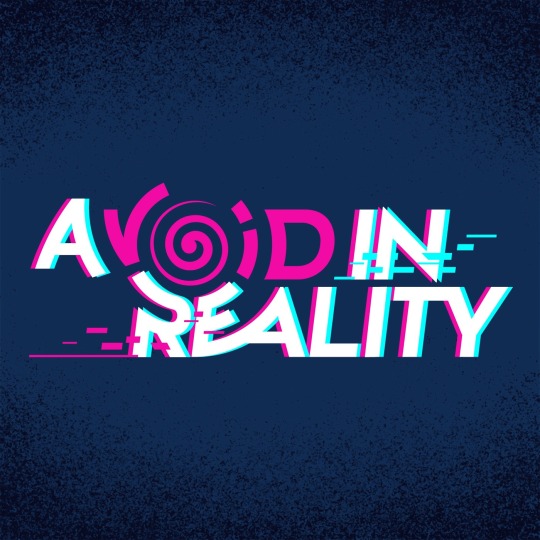
A Void in Reality
New Audio RPG!
A Fate Core TTRPG built using The Quiet Year set in a world built around a giant chasm and run by an eldritch corporation. Where the only way to do magic is to drain your own life force or someone else’s. Join our ragtag group where everyone is the quirky one and our most normal member is the five foot tall ferret.
https://redcircle.com/shows/avoidpod
https://feeds.redcircle.com/7692d527-f88c-49f6-9b6b-be676bf54360
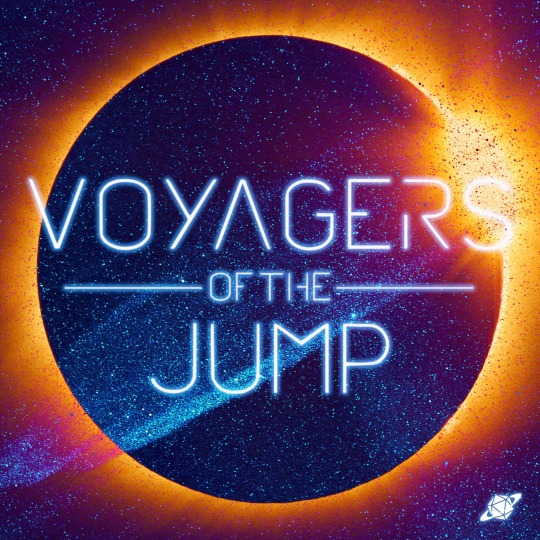
Voyagers of the Jump - An Original Traveller Campaign
New Audio RPG!
On the frontier of charted space, a ragtag crew of spacefarers gets the chance to start over and fix their lives, but only if they accept a dangerous mission that could avert a war—or start one. First published in 1977, Traveller is a science fiction RPG in the vein of The Expanse or Battlestar Galactica. Most who played the original game back in the day remember the robust character creation system where if you push too far and get unlucky with the dice, you can die before you even start playing. Voyagers of the Jump is an original adventure using the 2022 2nd Edition update to the Traveller RPG rules set by Mongoose Publishing.
https://www.glasscannonnetwork.com/shows/voyagers-of-the-jump
https://feeds.acast.com/public/shows/voyagersofthejump

Haunted City - A Blades in the Dark Campaign
New Audio RPG!
A city bathed in perpetual darkness, and a history not yet written. On the streets of Doskvol, it's kill or be killed as crews vie for power by any means necessary. Haunted City is a dark, twisted romp through a Victorian dystopia, using the rules of arguably the greatest RPG system of the modern era — Blades in the Dark.
https://www.glasscannonnetwork.com/shows/haunted-city
https://feeds.acast.com/public/shows/hauntedcity
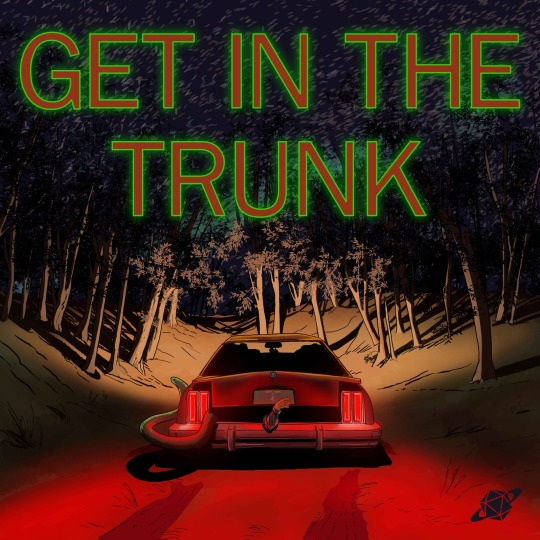
Get in the Trunk - A Delta Green Anthology Series
New Audio RPG!
Cosmic and supernatural horrors await the agents of Delta Green, a secret organization committed to protecting an unaware society—whatever the cost. This formerly exclusive anthology series with a rotating cast of players and handlers has quickly become the most sought-after show on the Network.
https://www.glasscannonnetwork.com/shows/get-in-the-trunk
https://feeds.acast.com/public/shows/getinthetrunk

Long Con
New Audio Drama!
Two brothers, Seth and Eric, as they stumble into the world of entrepreneurship with a mission that's as outrageous as it is heartwarming. When their father falls into a mysterious coma, they're left with a peculiar last wish: start a successful business. Armed with boundless enthusiasm, questionable ideas, and a flair for accidental chaos, these brothers will stop at nothing to fulfill their comatose dad's dreams.
https://podcasters.spotify.com/pod/show/who-let-you-in4
https://anchor.fm/s/e9cc28bc/podcast/rss

New Audio Drama!
When a new lead prompts a fresh look at a cold case, Special Agent Nicole Baumer is tasked with finding out what really happened to sixteen year old Erin Michaels. But as parallels surface between her past and Erin’s, Nicole must finally confront her own trauma in order to save her.
https://cms.megaphone.fm/channel/SBP2836325918
https://feeds.megaphone.fm/SBP2836325918

Lonely Boy
New Audio Drama!
Get to know Lonely Boy, a 10-episode fictional coming-of-age audio drama about pop sensation Frederick Julius as he takes a musical rewind through the defining moments of his youth. Each Friday we drop a new 25-30 minute episode including a fresh indie pop track inspired by the story. From grappling with his dad's misdeeds to mastering middle school melodrama to finding first love in the most unexpected places, you'll root for this legendary artist as he ultimately deciphers what kind of man he wants to be.
https://lonely-boy.captivate.fm
https://feeds.captivate.fm/lonely-boy/

The World According To Bards
New Audio RPG!
A D&D actual play podcast following three bards. The main rule here is “yes, and…” Join us on our thrilling adventure full of lighthearted comedy and general wackiness!
https://podcasters.spotify.com/pod/show/theworldaccordingtobards
https://anchor.fm/s/e96bc558/podcast/rss

Chronicles Of Pangea Ultima
New Audio Book!
The year is 250,000,000 AD. Meet Tyver α, descendant of Lloviant, who travelled to Pangea Ultima. This is not his home - he had not went here before.
https://rss.com/podcasts/chroniclesofpangeaultima
https://media.rss.com/chroniclesofpangeaultima/feed.xml
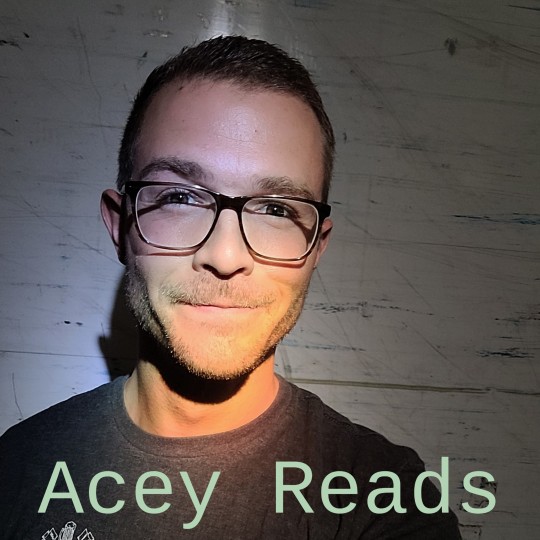
Acey Reads
New Audio Book!
Reading of original works by Acey Smith, and Sunflower Star Creative works.
https://aceyreads.podbean.com/
https://feed.podbean.com/aceyreads/feed.xml

Autumn Tales
New Audio Book!
Enter a brave, new world where the move of a single letter in a turn of phrase creates the unlikeliest of protagonists. With their own dreams and goals to pursue, each must navigate an ever-shifting landscape by working together.
https://autumntales.podbean.com/
https://feed.podbean.com/autumntales/feed.xml
24 notes
·
View notes
Text
Apparently, on twitter, there are some people still unaware of the massive teacher shortage in England and Wales. It does affect some subjects and some geographic areas more than others, so let’s talk about it and the impact on kids and the impact on wider society.

And you can see here, teacher recruitment in 2022 was down on every measure: https://explore-education-statistics.service.gov.uk/find-statistics/initial-teacher-training-census
Teacher retention is also in a dire state- according to the DfE, nearly 20% of new teachers quit within just 2 years, whilst nearly half leave within 10 years. Meanwhile, NEU surveys show 44% of all teachers are considering leaving the profession in the next 5 years- see here: https://neu.org.uk/press-releases/state-education-profession
These surveys also show more and more schools having unfilled vacancies for teaching or support staff.
What does this actually mean in practice in the classroom?
In 2019, pre-pandemic, I was looking for a new science teaching job. I went to a few interviews, and found a job relatively easily, but all of the interviews I went to had a good field of applicants, and it didn’t seem like vacancies were going unfilled.
Last year, I worked in a school who had a vacancy for a science teacher. We advertised throughout the year, and it took 2 terms to find a suitable applicant. I left my job at that school, and got a new one on the first interview I went to (this is not because I’m amazing, I was the best of a bad bunch, as it were). My job, unfortunately, was not filled for September. Colleagues teaching maths and MFL (among others) also left at the same time and their jobs weren’t filled. Another vacancy was filled with an ECT who would be moving to the area but she couldn’t take up the post due to not being able to find anywhere to rent!
There will be areas of the country where teachers read this, and think actually, it doesn’t look so bad!
I know schools in my county and in the city where I used to work who now have no qualified physics teachers in the school. I know schools making timetable adjustments to ensure all students get time with a qualified science or maths teacher. I know of PE, English, History teachers teaching science or maths. I know of schools where I’d estimate 10% of the workforce is long term supply (who, btw, can just walk out one day and not come back). I know trainees being offered jobs in November of their training year for the following September.
Out of curiosity I keep an eye on teacher vacancies in my county- I’m seeing the same ones being advertised over and over since September. There’s currently over 20 vacancies being advertised for “as soon as possible” starts.
And certainly forget about finding maternity cover for a lot of subjects- teachers have no need to take temporary contracts at the moment!
So, what does this look like for the kids?
It means they get a string of supply teachers, who may change week on week. It means not being taught by subject specialists. It means if their teacher leaves part way through the year (and teachers do) there is almost no chance of that teacher being replaced, and no spare capacity to juggle. Schools try their best to “protect” exam classes, but it doesn’t always happen.
These kids get poorer quality lessons, often little marking/feedback, and run the risk of missing bits of the exam syllabus. Often, they don’t get to do practical work in relevant subjects, or the practical work they do will be more limited. HoDs are stressed sorting cover, and their own classes get neglected. Teachers go off sick with stress, and the class gets a few weeks of cover (or maybe more if things are really bad).
It also means that kids go without form tutors- that first point of pastoral contact- and they might end up feeling like there’s no-one they can go to if they have a problem at school. (I know some kids feel like this anyway, but not having a form tutor or regular teachers can make things feel worse).
In primary schools, it can look like classes being covered by unqualfied TAs. I don’t want to criticise TAs at all, they are amazing BUT they do not have the training a teacher has, and they are paid much less, so usually won’t do planning or marking in the same way- which I don’t think ends up being great for the kids.
Ultimately, teacher shortages are at their very worst in subjects like science and maths, although they are also bad in MFL, Geography and increasingly English. I am not one of those STEM > everything people, but we do need engineers, doctors, HCPs, biomedical scientists, chemists, environmental scientists, and so on. These are the people who build our infrastructure, take care of us when we are ill and develop new treatments, and ultimately make our lives better. If we don’t have good education in these areas, it is a major problem for the country.
Anyway, this is a very long post to say “things are crap in schools right now, and this is why teachers are striking”.
88 notes
·
View notes
Text

Hubble sees boulders escaping from asteroid Dimorphos
Wayward asteroids present a real collision hazard to Earth. Scientists estimate that an asteroid measuring several miles across smashed into Earth 65 million years ago and wiped out the dinosaurs, among other forms of life, in a mass extinction. Unlike the dinosaurs, humanity can avoid this fate if we begin practicing how to knock an Earth-approaching asteroid off course.
This is trickier than how it has been depicted in science fiction movies like Deep Impact. Planetary scientists first need to know how asteroids were assembled. Are they flying rubble piles of loosely agglomerated rocks, or something more substantial? This information would help provide strategies on how to successfully deflect a menacing asteroid.
As a first step, NASA did an experiment to smash into an asteroid to see how it is perturbed. The DART (Double Asteroid Redirection Test) spacecraft impact on asteroid Dimorphos happened on September 26, 2022. Astronomers using the Hubble Space Telescope continue following the aftermath of the cosmic collision.
A surprise is the discovery of several dozen boulders lifted off the asteroid after the smashup. In Hubble pictures they look like a swarm of bees very slowly moving away from the asteroid. This might mean that smacking an Earth-approaching asteroid might result in a cluster of threatening boulders heading in our direction.
The popular 1954 rock song "Shake, Rattle and Roll," could be the theme music for the Hubble Space Telescope's latest discovery about what is happening to the asteroid Dimorphos in the aftermath of NASA's DART (Double Asteroid Redirection Test) experiment. DART intentionally impacted Dimorphos on September 26, 2022, slightly changing the trajectory of its orbit around the larger asteroid Didymos.
Astronomers using Hubble's extraordinary sensitivity have discovered a swarm of boulders that were possibly shaken off the asteroid when NASA deliberately slammed the half-ton DART impactor spacecraft into Dimorphos at approximately 14,000 miles per hour.
The 37 free-flung boulders range in size from three feet to 22 feet across, based on Hubble photometry. They are drifting away from the asteroid at little more than a half-mile per hour—roughly the walking speed of a giant tortoise. The total mass in these detected boulders is about 0.1% the mass of Dimorphos.
"This is a spectacular observation—much better than I expected. We see a cloud of boulders carrying mass and energy away from the impact target. The numbers, sizes, and shapes of the boulders are consistent with them having been knocked off the surface of Dimorphos by the impact," said David Jewitt of the University of California at Los Angeles, a planetary scientist who has been using Hubble to track changes in the asteroid during and after the DART impact.
"This tells us for the first time what happens when you hit an asteroid and see material coming out up to the largest sizes. The boulders are some of the faintest things ever imaged inside our solar system."
Jewitt says that this opens up a new dimension for studying the aftermath of the DART experiment using the European Space Agency's upcoming Hera spacecraft, which will arrive at the binary asteroid in late 2026. Hera will perform a detailed post-impact survey of the targeted asteroid.
"The boulder cloud will still be dispersing when Hera arrives," said Jewitt. "It's like a very slowly expanding swarm of bees that eventually will spread along the binary pair's orbit around the sun."
The boulders are most likely not shattered pieces of the diminutive asteroid caused by the impact. They were already scattered across the asteroid's surface, as evident in the last close-up picture taken by the DART spacecraft just two seconds before collision, when it was only seven miles above the surface.
Jewitt estimates that the impact shook off two percent of the boulders on the asteroid's surface. He says the boulder observations by Hubble also give an estimate for the size of the DART impact crater. "The boulders could have been excavated from a circle of about 160 feet across (the width of a football field) on the surface of Dimorphos," he said. Hera will eventually determine the actual crater size.
Long ago, Dimorphos may have formed from material shed into space by the larger asteroid Didymos. The parent body may have spun up too quickly or could have lost material from a glancing collision with another object, among other scenarios. The ejected material formed a ring that gravitationally coalesced to form Dimorphos. This would make it a flying rubble pile of rocky debris loosely held together by a relatively weak pull of gravity. Therefore, the interior is probably not solid, but has a structure more like a bunch of grapes.
It's not clear how the boulders were lifted off the asteroid's surface. They could be part of an ejecta plume that was photographed by Hubble and other observatories. Or a seismic wave from the impact may have rattled through the asteroid—like hitting a bell with a hammer—shaking lose the surface rubble.
"If we follow the boulders in future Hubble observations, then we may have enough data to pin down the boulders' precise trajectories. And then we'll see in which directions they were launched from the surface," said Jewitt.
The findings are published in The Astrophysical Journal Letters.
IMAGE....Image of the asteroid Dimorphos, with compass arrows, scale bar, and color key for reference. The north and east compass arrows show the orientation of the image on the sky. Note that the relationship between north and east on the sky (as seen from below) is flipped relative to direction arrows on a map of the ground (as seen from above). The bright white object at lower left is Dimorphos. It has a bluish dust tail extending diagonally to the upper right. A cluster of blue dots (marked by white circles) surrounds the asteroid. These are boulders that were knocked off the asteroid when, on September 26, 2022, NASA deliberately slammed the half-ton DART impactor spacecraft into the asteroid as a test of what it would take to deflect some future asteroid from hitting Earth. Hubble photographed the slow-moving boulders using the Wide Field Camera 3 in December 2022. The color results from assigning a blue hue to the monochromatic (grayscale) image. Credit: Image: NASA, ESA, David Jewitt (UCLA), Image Processing: Alyssa Pagan (STScI)
35 notes
·
View notes
Text
Dr. James S. Harrison taught history and humanities courses at Portland Community College (Cascade Campus) beginning in 1993 and eventually became Social Sciences Faculty Department Chair.
After receiving his BA, he served as a Peace Corps Volunteer teacher in Sierra Leone, West Africa. Subsequently, he earned an MA in US and African History from the City College of New York.
In 2016, he gave a talk called "Imagining a World Without Whiteness."
Dr. Harrison passed away in September 2022.
8 notes
·
View notes
Text
Since the start of Moscow’s full-scale invasion of Ukraine, the Russian authorities have begun integrating ideological and military-themed lessons into school curricula. However, their plans for the upcoming academic year are even more drastic. Children will receive instruction in combat training and learn how to use grenade launchers and automatic weapons, all as part of the required school curriculum. The Russian government has radically revised the list of social sciences, replacing them with militarized or ideological equivalents. Now, instead of economics and law, students will study “traditional values” and the “Russian world.” The independent outlet Holod explained Russia’s new educational model. Meduza shares an abridged version in English.
Russia's educational landscape has experienced significant shifts since the start of the full-scale war. In September 2022, schools across the country rolled out a new class called “Important Conversations,” a state-designed, “patriotic” lesson series meant to bring students’ spiritual and moral values in line with the Russian Federation’s National Security Strategy.
A year later, the Russian authorities supplemented this ideological teaching with military instruction. In addition to things like fire safety and first aid, students began learning “basic military training” in their “Fundamentals of Life Safety” classes. In 10th grade, they learn about the workings of the Kalashnikov assault rifle and “information-psychological warfare.”
Now, the Kremlin is looking to further expand ideological and military teaching in schools. From September 2024, “Fundamentals of Life Safety” will be replaced by something called “Fundamentals of Homeland Security and Defense.” (While related amendments to federal education law were made in July 2023, the program was only officially registered with the Justice Ministry on February 29, 2024.)
A child today, a soldier tomorrow
“Fundamentals of Homeland Security and Defense” (FHSD) is approved for students as young as those in fifth grade, but from eighth grade, the course is mandatory. Among other things, eighth and ninth graders will be taught about the tactical and technical characteristics of the Dragunov sniper rifle, the RPG-7 handheld anti-tank grenade launcher, the Kalashnikov assault rifle, and various hand grenades. Students will also study drill training, general military regulations, “the essence and importance of military discipline,” and “the essence of unified command.”
Instructors are tasked with fostering specific “personal results” in students by the program’s conclusion, including “a responsible attitude toward fulfilling one’s constitutional duty of defending the Fatherland” and “an understanding of the significance of the military oath.”
By ninth grade, students are expected to master skills such as putting on equipment and body armor, “assessing the risks of violating military discipline,” and performing drill exercises. Over the two following years, the program goes even deeper. Tenth and 11th graders will learn the basics of combined arms combat, how to set up a combat unit’s position, and how to use more modern firearms such as the MP-443 Grach pistol and the AK-12 assault rifle.
The FHSD program has between 136 and 238 lessons, depending on the grade level at which it’s introduced. Since schools can independently decide how many hours to allocate for each unit (there are still traditional topics such as disaster preparedness and response), this could add dozens of military lessons to those already required in the “basic military training” block. As a result, a significant portion of the school curriculum will focus on military training and preparing future soldiers for combat.
The Russian authorities plan to tap “special military operation” veterans to help teach the new subject, according to First Deputy Education Minister Alexander Bugaev, who said the ex-soldiers will fill an “invaluable niche [in schools by transferring] their personal experience.”
These veterans will be prepared for their new teaching career at the Vertex Center for Military Patriotic Education at Russia’s Federal State University of Education. After just 36 hours of training, a former soldier can get a document certifying them to teach in schools. In addition to retraining war participants as teachers, the center will organize military games for children. Officially, the university’s vice rector, Alexey Ryabtsev, heads the program, but the actual work is likely to fall to his deputy, Pyotr Ishkov, who served as deputy education minister of the self-proclaimed “Luhansk People’s Republic” in 2022. However, details about the center itself and its educational programs remain scarce.
Integrated ideology
Russian schools are also set to make big changes to core classes. Russia’s Education Ministry has already drafted a law that would replace social studies in sixth through eighth grade with something called “Our Region’s History.” While social studies will still be taught in high school, many Russians leave school after ninth grade to go to trade schools.
Less than half of the topics covered in “Our Region’s History” will actually touch on local history because the course is meant to incorporate topics from an existing discipline, “Fundamentals of the Spiritual and Moral Culture of the Russian Peoples.”
Course topics include: “The Traditional Family,” “Risks and Threats to the Spiritual and Moral Culture of Russia,” “The Russian World,” “Russian Language — the Basis of Russian Culture,” “Spiritual and Moral Values of the Russian People,” “Unity of Values in Russia’s Religions,” “Heroes of the Armed Forces,” and “The Citizen’s Duty to Society.”
Students will still have separate “Important Conversations” classes, but now state ideology will also be integrated into and dispersed across regular subjects.
Previously, ideological subjects could be mostly ignored. While they might influence awards at school, they didn’t have an impact on college admissions. Now that ideology has been added to the core school curriculum, though, related topics will be included on Russia’s college aptitude test, the Unified State Exam (EGE).
Students planning to take the history EGE are now required to know the reasons for “The Revival of the Russian Federation as a World Power,” “The Reunification of Crimea with Russia,” and “The Special Military Operation in Ukraine.” In 2023, only Russia’s annexation of Crimea was included.
In 2024, the list of topics students should know for the EGE in social studies includes things like “The Spiritual Values of Russian Society,” and “The Russian Federation’s State Policy to Counter Extremism.” Neither of these topics was on the exam last year.
5 notes
·
View notes
Text
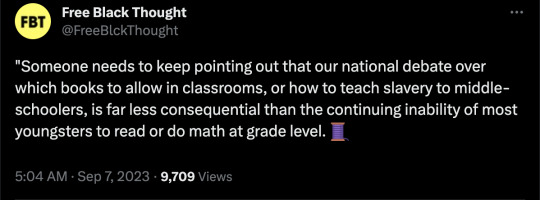

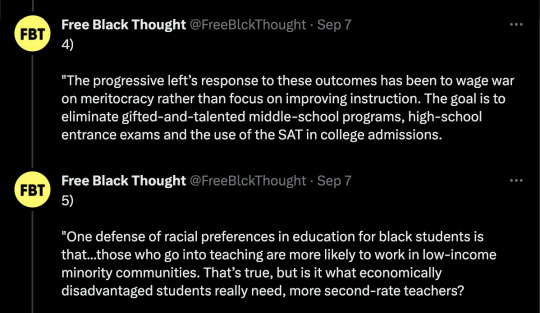

By: Jason L. Riley
Published: Sep 5, 2023
Yes, this is another September “back to school” column. My apologies. But someone needs to keep pointing out that our national debate over which books to allow in classrooms, or how to teach slavery to middle-schoolers, is far less consequential than the continuing inability of most youngsters to read or do math at grade level.
In Florida, where GOP governor and presidential candidate Ron DeSantis has taken lumps for a couple sentences in a 200-page black-history curriculum, only 39% of Miami-Dade County fourth-graders are proficient in reading, according to a Miami Herald report last year on standardized test results. By eighth grade the number drops to 31%, and math scores are just as bad. Who cares if kids have access to books by Toni Morrison or Jodi Picoult if most of them can’t comprehend the contents?
These dismal outcomes have persisted nationwide for decades, and the racial achievement gap is even more disturbing. The U.S. Education Department reported last year that in 2022 the average reading score for black fourth-graders in New York on the National Assessment of Educational Progress trailed that of white fourth graders by 29 points. This “performance gap was not significantly different from that in 1998,” the report added.
The progressive left’s response to these outcomes has been to wage war on meritocracy rather than focus on improving instruction. The goal is to eliminate gifted-and-talented middle-school programs, high-school entrance exams and the use of the SAT in college admissions. One defense of racial preferences in education for black students is that recipients, including those who go into teaching, are more likely to work in low-income minority communities after graduation. That’s true, but is it what economically disadvantaged students really need, more second-rate teachers?
In his lively autobiography, “Up From the Projects,” the late economist Walter Williams related an incident from his teaching days at California State University, Los Angeles in the late 1960s. A black student approached him at the end of the course and said he needed a B to graduate. The student told Williams that he wanted to teach school in Watts, a predominantly black section of Los Angeles. Williams replied that Watts didn’t need any more mediocre educators. He added, jokingly, “If you’d said San Fernando Valley”—a predominantly white area back then—“I’d have given you the B.”
Williams was appalled that many of his academic colleagues were holding their black students to lower standards. “There was no more effective way to mislead black students and discredit whatever legitimate achievements they might make than giving them phony grades and ultimately fraudulent diplomas,” he wrote. Sadly, the downstream effects of lax standards for black students that concerned him more than 50 years ago have only gotten worse.
Medical students in all 50 states must pass a licensure exam before they can practice. The exam has three parts, and Step 1 is administered at the end of the second year of medical school. It measures your grasp of basic science topics—anatomy, biology, biochemistry, pharmacology—and is highly predictive of how you will perform in medical school going forward.
A student’s numerical score on the Step 1 exam has long been the most important tool in evaluating candidates for the most competitive medical disciplines and residency programs. Three years ago, representatives of the nation’s leading medical groups voted to scrap numerical scores and report the results of the Step 1 exam as pass/fail.
The reason is simple, according to Stanley Goldfarb, an academic physician and former associate dean of curriculum at the University of Pennsylvania’s medical school. In a recent book on how social-justice activism has affected medical training, “Take Two Aspirin and Call Me By My Pronouns,” Dr. Goldfarb explained that black students underperform on the Step 1 exam. “The solution to the fact that white students score better on the exam was to eliminate reporting scores,” he wrote, which “makes about as much sense as Major League Baseball eliminating batting averages to assure that no ethnic cohort outperforms the others.”
Dr. Goldfarb’s book has an amusing title—which comes from an op-ed he wrote for this paper in 2019—but what it describes is nothing to laugh at. Those who complain about racial disparities in medical outcomes might consider how racial double standards contribute to them. Medical schools have been pressured to relax admission standards for diversity purposes, which has led to the relaxation of grading standards and licensure requirements.
Black doctors are more likely than white doctors to practice in medically underserved areas, but low-income blacks need second-rate doctors even less than they need second-rate teachers. For whatever reason, it seems lost on progressives that addressing the racial achievement gap in K-12 education would go a long way toward addressing the one in medical school.
[ Via: https://archive.is/HXGgR ]
==
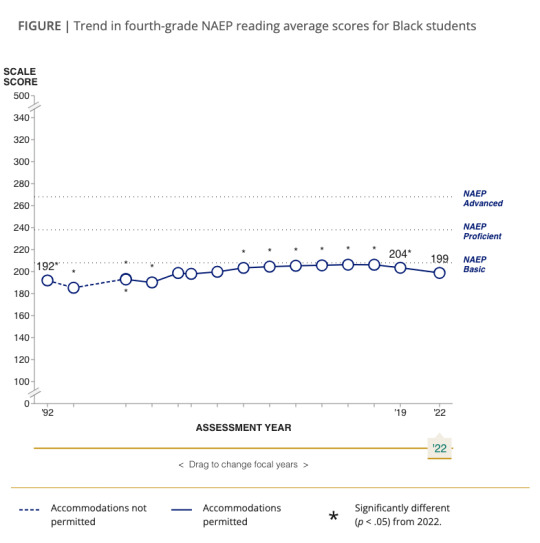

[ Source: National Student Group Scores and Score Gaps (Reading, Grade 4) ]
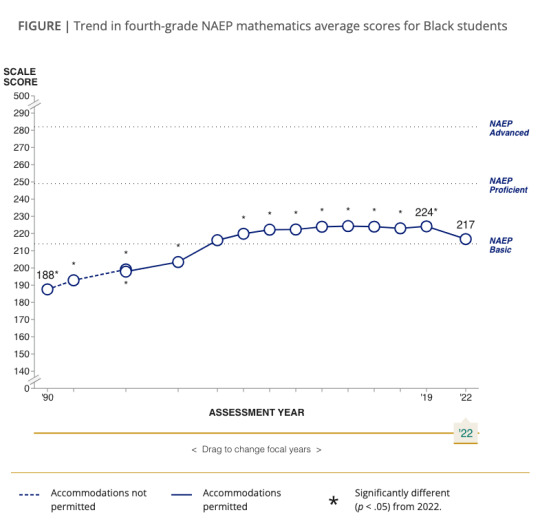

[ Source: National Student Group Scores and Score Gaps (Math, Grade 4) ]

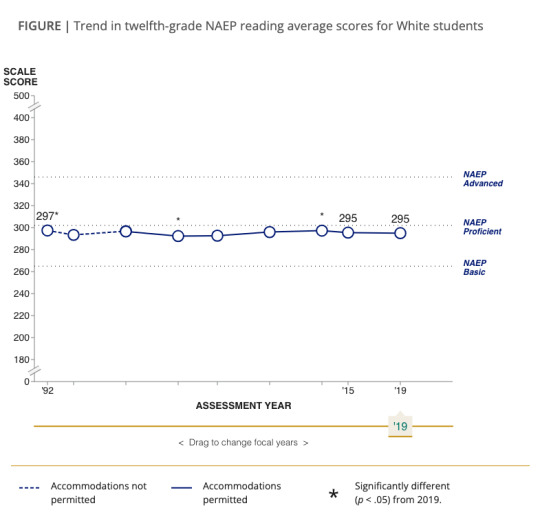
[ Source: National Student Group Scores and Score Gaps (Reading, Grade 12) ]


[ Source: National Student Group Scores and Score Gaps (Math, Grade 12) ]
This is honestly the thing that's the most troubling. There are activists in schools masquerading as teachers who insist it's a moral imperative to teach young children complicated postmodern intersectional conspiracy theories, yet can't - or won't - actually teach those same kids to read.
"Antiracist" teachers behaving like black kids don't need to learn to read, and it's more important that they understand their place in a perverted conception of social hierarchy, is a disturbing rehabilitation of the KKK's golden years.
#Jason L. Riley#bigotry of low expectations#merit#make merit matter#meritocracy#low standards#education#reading#literacy#antiracism#antiracism as religion#neoracism#religion is a mental illness
14 notes
·
View notes
Text
I posted 25 times in 2022
25 posts created (100%)
0 posts reblogged (0%)
I tagged 25 of my posts in 2022
#vintage - 25 posts
#paperback - 25 posts
#book - 23 posts
#science fiction - 19 posts
#1970s - 14 posts
#anthology - 7 posts
#unknown artist - 6 posts
#1980s - 6 posts
#1960s - 5 posts
#ace books - 5 posts
Longest Tag: 30 characters
#the league of green-eyed women
My Top Posts in 2022:
#5

Isaac Asimov's Magical Worlds of Fantasy 4: Spells, edited by Isaac Asimov, Martin H. Greenberg and Charles G. Waugh, cover by Kinuko Y. Craft (1985)
124 notes - Posted April 8, 2022
#4

The League of Grey-Eyed Women by Julius Fast, cover by Unknown Artist (1971)
The cover artist is possibly Bob Pepper.
124 notes - Posted January 11, 2022
#3

Chthon by Piers Anthony, cover by John Jude Palencar (1987)
149 notes - Posted May 17, 2022
#2

New Writings in SF 21, edited by John Carnell, cover by Unknown Artist (1973)
262 notes - Posted July 12, 2022
My #1 post of 2022

The Silkie by A. E. van Vogt, cover by Bart Forbes (1974)
536 notes - Posted September 20, 2022
Get your Tumblr 2022 Year in Review →
#tumblr2022#year in review#my 2022 tumblr year in review#your tumblr year in review#paperback#vintage#book#science fiction#illustration#fantasy#art#covers
58 notes
·
View notes
Text
headline round-up! here's some recent positive and/or peculiar news that crossed my feed:

Hawaiian monk seal population surpasses 1,500! (via NOAA Fisheries, May 2022) Thanks to diligent conservation work, this endangered species is at its highest population size in over 20 years.

Stingray sets new record for largest freshwater fish (via NYT and Guiness Word Records, June 2022) This 300kg giant freshwater stingray (Urogymnus polylepis) was caught in northern Cambodia.

150 southern fin whales observed feeding together (via Science Daily and Twitter, July 2022) Fin whales (Balaenoptera physalus quoyi) were hunted to near extinction before the commercial whaling ban in 1976. These feeding groups are the largest documented with modern methods.

Meet the K Pod's newest member! (via Center for Whale Research and Puget Sound Institute, July 2022) Designated K45, this is the first documented calf born in the K Pod of Southern Resident orcas since 2011.
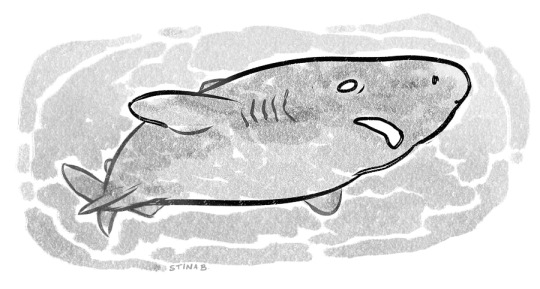
A Greenland shark caught near Belize (via NPR, July 2022) Researchers tagging tiger sharks had quite the surprise when they found a Greenland shark, one of the longest-lived animals on Earth, typically found in the Arctic.

Albatrosses from space! (via British Antarctic Survey, September 2022) You can assist albatross conservation efforts by joining this citizen science project. "Albatross detectives" help search through thousands of satellite images to count birds as they nest on remote islands.
#animals#wildlife#good news#whales#birds#seals#illustration#doodles#id in alt#as mentioned in my last patreon blog#i'm going to start doing posts like this for good/interesting news#working through a backlog of saved articles so i gave this one a marine theme to narrow it down#making no promises about frequency yet but#i think it'll be easier than my previous attempt at a more complex illustration + write-up for each story#hope you all still enjoy it!
112 notes
·
View notes